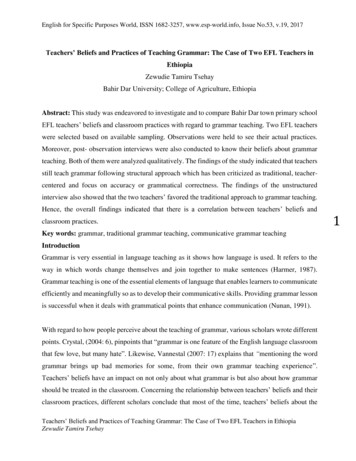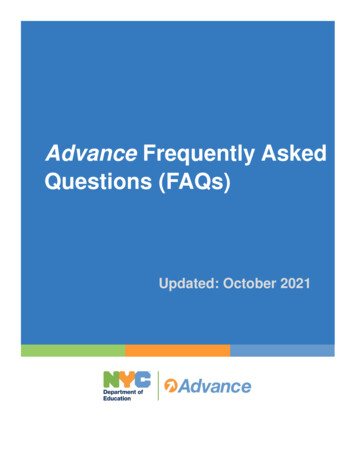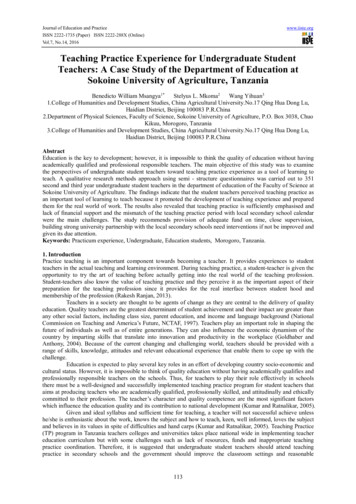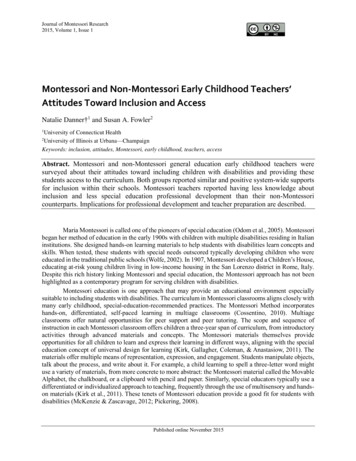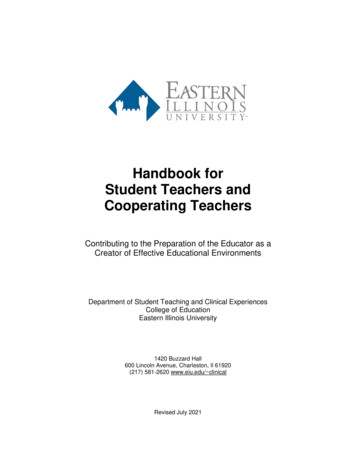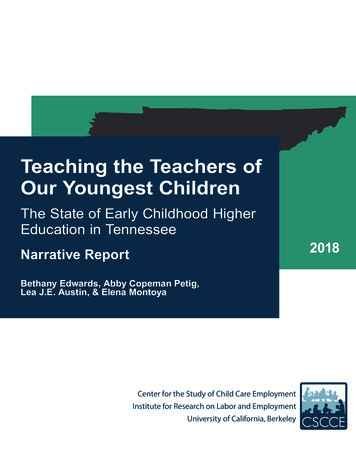
Transcription
Teaching the Teachers ofOur Youngest ChildrenThe State of Early Childhood HigherEducation in Tennessee2018Narrative ReportBethany Edwards, Abby Copeman Petig,Lea J.E. Austin, & Elena MontoyaCenter for the Study of Child Care EmploymentInstitute for Research on Labor and EmploymentUniversity of California, Berkeley
Teaching the Teachers of Our Youngest ChildrenThe State of Early Childhood Higher Education in Tennessee 2018 Center for the Study of Child Care Employment. All rights reserved.Suggested Citation:Edwards, B., Copeman Petig, A., Austin, L.J.E., & Montoya, E. (2018). Teaching the Teachers of OurYoungest Children: The State of Early Childhood Higher Education in Tennessee. Berkeley, CA: Centerfor the Study of Child Care Employment, University of California, Berkeley.Center for the Study of Child Care EmploymentInstitute for Research on Labor and EmploymentUniversity of California, Berkeley2521 Channing Way #5555Berkeley, CA 94720(510) 643-8293http://cscce.berkeley.edu/The Center for the Study of Child Care Employment (CSCCE) was founded in 1999 to focus on achievingcomprehensive public investments that enable and reward the early childhood workforce to deliver highquality care and education for all children. To achieve this goal, CSCCE conducts cutting-edge researchand proposes policy solutions aimed at improving how our nation prepares, supports, and rewards theearly care and education workforce to ensure young children’s optimal development.AcknowledgementsTeaching the Teachers of Our Youngest Children: The State of Early Childhood Higher Education inTennessee was funded by the Bill & Melinda Gates Foundation.Special thanks to the program leads and faculty members who gave generously of their time to participatein the Tennessee Early Childhood Higher Education Inventory.Additional thanks to the Tennessee Office of Early Learning, the Tennessee Commission on Children andYouth, the Tennessee Early Childhood Training Alliance, and staff at Middle Tennessee State Universityfor providing expertise and sharing knowledge about Tennessee’s early childhood system.We are also grateful to Lisa Qing for her assistance in preparing this report.The views presented in this report are those of the authors.Editor: Deborah MeachamiThe State of Early Childhood Higher Education in TennesseeCenter for the Study of Child Care Employment, University of California, Berkeley
Table of ContentsIntroduction1The Early Childhood Higher Education Landscape in Tennessee4Findings7Part 1. Early Childhood Higher Education, Mapping the Scene7Finding One: Program Offerings8Finding Two: Field-Based Learning Experiences15Finding Three: Portrait of Faculty20Finding Four: Faculty Perspectives and Expertise26Finding Five: Supporting Students32Finding Six: Program Challenges35Part 2. Early Childhood Higher Education, An Evolving Landscapeii37Finding Seven: Family Engagement37Finding Eight: Early Mathematics42Finding Nine: Dual Language Learners46Discussion and Recommendations52Concluding Thoughts57References58The State of Early Childhood Higher Education in TennesseeCenter for the Study of Child Care Employment, University of California, Berkeley
List of TablesTable 1.Tennessee Minimum Education Requirements for Select RolesTable 2.List of Domains and Topics of Course Content Included in the Tennessee InventoryTable 3.Number and Mean Hours of Practica Required by Programs Participating in the TennesseeInventoryTable 4.List of Family Engagement Topics Included in the Tennessee InventoryTable 5.List of Early Mathematics Topics Included in the Tennessee InventoryTable 6.List of Early Mathematics Professional Development Topics Included in the TennesseeInventoryTable 7.List of Topics Related to Teaching Young Dual Language Learners (DLLs) Included in theTennessee InventoryiiiThe State of Early Childhood Higher Education in TennesseeCenter for the Study of Child Care Employment, University of California, Berkeley
List of FiguresFigure 1.Primary Goal of Tennessee Early Childhood Degree Programs, by Degree LevelFigure 2.Required Coursework Related to Child Development and Learning, by Degree LevelFigure 3.Child Development Theory and Its Relationship to Teaching: Required Age-Group Focusof Programs Participating in the Tennessee Inventory, by Degree LevelFigure 4.Field Experiences Required in Tennessee Early Childhood Degree Programs, by DegreeLevelFigure 5.Required Age-Group Focus in Practicum ExperiencesFigure 6.Select Practices Required for Students in Their Practicum ExperiencesFigure 7.Race/Ethnicity of Faculty Members Participating in the Tennessee Inventory, by DegreeLevelFigure 8.Age of Faculty Members Participating in the Tennessee Inventory, by Degree LevelFigure 9.Age-Group Focus of Select Job Roles in Past 10 YearsFigure 10.Importance of Including “Understanding the Components and Sequence of LiteracyDevelopment” in Teacher Preparation Programs: Percentage of Faculty MembersReporting "Very Important," by Age Group and Degree LevelFigure 11.Recent Teaching Experience: Percentage of Faculty Members Reporting Having TaughtContent Area in Past Two Years, by Degree LevelFigure 12.Interest in Professional Development Related to Diverse Child Populations Reported byFaculty Members Participating in the Tennessee Inventory: Percentage Reporting "VeryInterested," by Degree LevelFigure 13.Program-Related Challenges Reported by Faculty Members Participating in theTennessee InventoryFigure 14.Working With Families to Enhance Children’s Learning at Home: Required Age-GroupFocus of Programs Participating in the Tennessee Inventory, by Degree LevelFigure 15.Interest in Professional Development Related to Family Engagement Reported byFaculty Members Participating in the Tennessee Inventory: Percentage Reporting “VeryInterested,” by Degree LevelFigure 16.Building on Children’s Natural Interest in Mathematics: Capacity to Prepare Teachers toWork With Children of Various Ages, as Reported by Faculty Members Participating inthe Tennessee Inventory, by Degree LevelivThe State of Early Childhood Higher Education in TennesseeCenter for the Study of Child Care Employment, University of California, Berkeley
vFigure 17.Strategies to Support the Literacy Development of Young Dual Language Learners:Required Age-Group Focus of Programs Participating in the Tennessee Inventory, byDegree LevelFigure 18.Capacity to Prepare Teachers to Support and Promote Children's Development, asReported by Faculty Members Participating in the Tennessee Inventory, by Degree LevelFigure 19.Interest in Professional Development Related to Dual Language Learners (DLLs)Reported by Faculty Members Participating in the Tennessee Inventory: PercentageReporting "Very Interested," by Degree LevelThe State of Early Childhood Higher Education in TennesseeCenter for the Study of Child Care Employment, University of California, Berkeley
IntroductionThe importance of early care and education (ECE) to children’s lifelong learning and to our nation’seconomic well-being is recognized up to the highest levels of government and in businesses, schools, andliving rooms across the country. This understanding represents a dramatic shift from earlier decades andcarries with it heightened expectations for what teachers of young children should know and be able to do(Whitebook, Phillips, & Howes, 2014), especially in light of mounting evidence about inadequate andunequal educational quality for many children, particularly those of color and those living in low-incomefamilies (Hernandez, 2011; Karoly, 2009; Yoshikawa et al., 2013).As noted in the Early Childhood Workforce Index (Whitebook, McLean, & Austin, 2016), progress towardan equitable, efficient, and effective early childhood system requires advancing preparation, workplacesupports, and compensation of the workforce simultaneously. Adequate preparation for teachers,workplace supports that allow for ongoing reflection and development, and appropriate compensation areall variables that are necessary to attract and retain a skilled workforce. Making progress in each of thesethree areas additionally requires building solid foundations for these policies by securing sufficient financialresources and collecting quality, comprehensive workforce data. Further sources of public funding areneeded to stimulate the incubation and testing of sustainable policies to resolve compensation and otherissues that have gone largely unaddressed. Data on the early childhood workforce, across all settings andages of children, must be collected in order to test the effectiveness of policies for preparation, support, andreward. All five ingredients are essential — each one individually cannot advance effectively without theothers — but quality data and sufficient resources are fundamental.The Early Childhood Higher Education Inventory II (CSCCE, 2016) is an effort designed to collect baselinedata and inform the workforce preparation aspect of quality early childhood education. The Inventory is aresearch tool used to describe the landscape of a state’s early childhood degree program offerings at theassociate, bachelor’s, and graduate degree levels and to provide a portrait of early childhood highereducation faculty members.1 The Inventory describes early childhood degree programs offered in the state,focusing on variations in program content, age-group focus, student field-based learning, and facultycharacteristics (see Box 1 for a description of Inventory methodology).Through research, observation, and experience, we know that early educators play a central and criticalrole in the development and learning of infants, toddlers, and preschool-age children. In 2015, the Instituteof Medicine and the National Research Council of the National Academies of Sciences, Engineering, andMedicine asserted that teaching young children requires knowledge and skills just as complex as thoserequired to teach older children and issued several recommendations to strengthen professionalpreparation standards for early childhood practitioners and the institutions responsible for their preparationand ongoing learning. Transforming the Workforce for Children Birth Through Age 8: A Unifying Foundation(Institute of Medicine [IOM] & National Research Council [NRC], 2015) includes among its1Tennessee is one of 13 states (along with Arkansas, California, Florida, Indiana, Mississippi, Nebraska, NewHampshire, New Jersey, New York, Oregon, Rhode Island, and Washington) in which the Inventory has beencompleted at the time of publication of this report.1The State of Early Childhood Higher Education in TennesseeCenter for the Study of Child Care Employment, University of California, Berkeley
recommendations: 1) the strengthening of competency-based qualifications for all early educators andtransition to a minimum requirement of a bachelor’s degree, with specialized knowledge and competencies,for all lead teachers working with children from birth to age eight; and 2) the development and enhancementof interdisciplinary higher education programs for ECE professionals, including practice-based andsupervised learning opportunities.In addition, the IOM/NRC report documented the need to strengthen early educator competencies alongmultiple dimensions, including mathematics, family engagement, and support for dual language learners(IOM & NRC, 2015). While the link between young children’s math competency and later school successhas been demonstrated in recent research, there is concern that institutions of higher education are notadequately preparing teachers of young children to assess or facilitate children’s mathematicalunderstanding and skills (Ryan, Whitebook, & Cassidy, 2014). Additionally, given research evidence thatfamily involvement in children’s learning at home and at school contributes to school success (Dearing &Tang, 2010; Reynolds & Shlafer, 2010), we were interested in learning the extent to which early childhooddegree programs are addressing the topic of engaging with families to enhance children’s learning. A seriesof questions developed for the Inventory focuses specifically on these issues, with particular attention toprogram content and faculty attitudes. Finally, while many teachers of young children are monolingual(speaking only English), census data indicate that nationally more than one-quarter of children under agesix speak more than one language (Capps, Fix, Ost, Reardon-Anderson, & Passel, 2004). In light of thisreality, the Inventory examines the capacity of early childhood degree programs to prepare their studentsto teach dual language learners.Teacher preparation in the field of ECE has historically included a variety of higher education degreeprograms in various child-related disciplines, all of which have generally been considered equallyacceptable. Too often, these highly diverse degree programs are assumed to produce equivalent results(Maxwell, Lim, & Early, 2006; Whitebook et al., 2012). In contrast, programs to prepare teachers andadministrators to work with older children reflect far greater uniformity and stringency related to specificpreparation standards and certification requirements. In recent years, however, rising expectations aboutthe knowledge and skills that early childhood practitioners need to work effectively with young childrenbefore kindergarten, along with the introduction of new ECE programs and standards, have led manystakeholders to question whether the current array of early childhood-related degree programs can beassumed to produce equivalent results.Tennessee is home to more than 463,000 children under the age of six. Sixty-three percent of these youngchildren have all available parents in the workforce and, thus, potentially need child care (Annie E. CaseyFoundation, 2016). Stakeholders and advocates in Tennessee remain committed to advancing strategiesthat improve ECE services, including workforce preparation and development in order to ensure that earlyeducators have what they need to meet the complex needs of young children. Critical to these efforts is theestablishment of a well-coordinated, comprehensive professional preparation and development system thatcan prepare and support an incoming generation of educators, while also strengthening the skills of theexisting early education workforce. Institutions of higher education are crucial to meeting the evolving andincreasing demands identified as improving developmental and learning outcomes for the state’s youngchild population.The Inventory was implemented in Tennessee during the 2017-2018 academic year. The totality of the datacollected through the Inventory allows stakeholders to identify gaps and opportunities in the availableofferings and to assess the capacity of the state’s higher education system over time. This report2The State of Early Childhood Higher Education in TennesseeCenter for the Study of Child Care Employment, University of California, Berkeley
summarizes major findings collected through program and faculty modules of the Inventory (CSCCE, 2016)and provides recommendations for policy changes that could lead to more effective teacher practices tosupport children’s learning. An accompanying technical report presents more detailed findings.3The State of Early Childhood Higher Education in TennesseeCenter for the Study of Child Care Employment, University of California, Berkeley
The Early Childhood Higher Education Landscape inTennesseeA network of 11 community colleges and 23 public and private universities offers an array of early childhooddegree programs, serving prospective and current early childhood practitioners across the state. 2 Thisnetwork of higher education institutions offers 26 associate degree programs, 41 bachelor’s degreeprograms, 22 master’s degree programs, and four doctoral degree programs. In the current study, twothirds (67 percent) of both associate and bachelor’s degree programs as well as a majority (60 percent) ofgraduate degree programs reported serving a mix of those already working in the ECE field and moretraditional pre-service students.The Inventory findings are presented in two sections. The first section, “Early Childhood Higher Education,Mapping the Scene,” examines the extent to which Tennessee early childhood degree programs: Offer the knowledge, skills, and experiences associated with effective teaching practice andprogram leadership;Have a faculty workforce prepared to provide early childhood practitioners with the necessaryknowledge and skills associated with effective teaching practice and program leadership; andHave the resources to support student and faculty success.The second section of this report, “Early Childhood Higher Education, An Evolving Landscape,” examineshow these institutions of higher education are adapting to emerging knowledge about children’s learningand development. Specifically, the report explores the extent to which Tennessee early childhood degreeprograms have incorporated recent findings related to the importance of: Promoting early mathematical understanding;Engaging families to support young children’s optimal development, learning, and schoolsuccess; andTeaching young dual language learners.2The colleges and universities that participated in the Inventory estimated that during the 2015-2016 academic year,1,066 students were registered in associate degree programs, 641 students were registered in bachelor’s degreeprograms, and 102 students were registered in graduate degree programs. These same colleges and universitiesestimated that during this same time period, they conferred 78 associate degrees, 192 bachelor’s degrees, and 20graduate degrees.4The State of Early Childhood Higher Education in TennesseeCenter for the Study of Child Care Employment, University of California, Berkeley
Box 1. Study DesignDuring the 2017-2018 academic year, researchers from CSCCE implemented the Early ChildhoodHigher Education Inventory II, which consists of three modules: a mapping of the population of highereducation programs within a state; an online program survey completed by the degree program lead(e.g., dean, chair, or coordinator); and an online faculty survey completed by individual facultymembers. The program findings reported here are drawn from a final sample of 15 associate and 15bachelor’s degree programs. 3The faculty findings are drawn from a final sample of 14 community college faculty members and 31university faculty members.See the Technical Report for a detailed description of the methods of this study, including the samplingframe and selection, field procedures, response rate, and survey questions, along with detailed findingsfrom the Inventory.3Data were also collected from nine master’s degree programs and one doctoral degree program in Tennesseespecifically identified as early childhood education. As data for these graduate programs cannot be de-identified,program data collected for these early childhood degree programs are not included in this report.5The State of Early Childhood Higher Education in TennesseeCenter for the Study of Child Care Employment, University of California, Berkeley
Distribution of Tennessee Early Childhood Degree ProgramsLegend: No Early Childhood Degree Program Associate Bachelor’s Associate and Bachelor’s Bachelor’s and Graduate Associate, Bachelor’s, and Graduate6The State of Early Childhood Higher Education in TennesseeCenter for the Study of Child Care Employment, University of California, Berkeley
Part 1: Early Childhood HigherEducation, Mapping the SceneThis section of the report examines program offerings, faculty characteristics, student supports,and institutional challenges.What we asked about program goals, course content, and age-groupfocus:Program leads participating in the Inventory (e.g., deans, coordinators) were asked to indicate theprimary goal of their degree program(s) from among five options:1. To prepare students for teaching and/or administrative roles in early childhood educationsettings only;2. To prepare students for teaching and/or administrative roles in early childhood and elementaryeducation settings;3. To prepare students for the role of early interventionist or early childhood special educator;4. To prepare students for multiple roles involving young children, working in many types ofsettings; or5. To prepare students for a career as a researcher or a college-level faculty member.Program leads were also asked to identify course content topics for the degree related to:1. Child development and learning;2. Teaching, with three primary categories: Teaching diverse child populations; Teaching and curriculum; and Teaching skills in early childhood settings; and3. Administration and leadership.For the child development and learning domain as well as the teaching domains, respondents wereasked to indicate whether a series of specific topics were required and, if so, the specific age-group orgrade-level focus of each topic. For the leadership and administration domain, respondents were askedto identify course content topics offered to students in the degree program (see Table 2).Program leads were also asked what standards or competencies degree programs incorporated intotheir coursework.7The State of Early Childhood Higher Education in TennesseeCenter for the Study of Child Care Employment, University of California, Berkeley
Most Tennessee early childhood degreeprograms identify their primary goal as teacherFINDING ONE: PROGRAM OFFERINGSpreparation across early childhood andGoals, Course Content, and Age-Group Focuselementary school settings. While theseprograms offer a range of topics related to childdevelopment and approaches to teaching, the age-group focus varied, depending on degree level.Associate degree programs were equally likely to require a focus on all age groups, birth throughelementary school, while bachelor’s degree programs were more likely to focus on elementary schoolchildren. Availability of content related to administration and leadership is inconsistent across degree levels.Like most states across the country, education requirements in Tennessee for those administering orteaching in early care and education programs vary and depend more on the program’s funding sourcethan children’s developmental needs (Whitebook et al., 2016). In Tennessee, there are differentrequirements for those teaching in group child care homes, family child care homes, child care centers, andstate and federally sponsored preschools (see Table 1).4 Such divergent qualifications disadvantageeducators across Tennessee’s ECE field as well as children who may have teachers with vastly differentexperience and qualifications, depending on the setting in which they receive care and education services.Table 1. Tennessee Minimum Education Requirements for Select RolesType of ProgramRoleMinimum Education RequirementsFamily child care homesPrimary caregiverNo secondary or post-secondaryeducational requirementsGroup child care homesPrimary caregiverHigh school diploma or equivalentChild care centerCaregiverHead StartLead teacherPublic preschoolLead teacherNo secondary or post-secondaryeducational requirements*Associate degree in child development orearly childhood educationBachelor’s degree from approved educatorpreparation program*One caregiver per group must have a high school diploma or equivalent.Sources: Tennessee Department of Human Services. Child Care Laws, Rules, Guidelines & Policies (Public Chapter1070). oliciespublic-chapter-1070.html; Tennessee Department of Education. Educator Licensure & .html; U.S. Department of Health & Human Services. Head Start ProgramPerformance Standards. f-qualifications.It is likely, however, that many early childhood teaching staff in Tennessee mirror their counterpartsnationally and possess higher levels of education and training than may be required (Whitebook et al.,2016). Additionally, state and local initiatives may encourage and support many professionals in the ECEworkforce to pursue further college-level education. The Report Card and Rated Licensing System,Tennessee’s statewide Quality Rating and Improvement System (QRIS), requires higher levels of staffeducation to achieve higher ratings. 54Family child care homes are licensed to serve five to seven children, and group child care homes are licensed toserve eight to 12 children.5 QRIS standards are published by the Tennessee Department of Human Services. Find more information ity-program.html.8The State of Early Childhood Higher Education in TennesseeCenter for the Study of Child Care Employment, University of California, Berkeley
Program GoalsNot all early childhood degree programs are alike, nor should they be. However, it is important to distinguishbetween programs that have an intent to prepare teachers and administrators and those that identify othergoals related to early childhood. Reflecting the inconsistent qualifications required of early educators,across the country there has been a default acceptance of “early childhood-related” programs as acceptablefor preparing early educators (Whitebook et al., 2012). This reality has resulted in wide variation in the goalsand content of programs, though graduates of these different programs are often held to the sameexpectation of what they should know and be able to do upon degree completion (Whitebook & Ryan,2011).The primary focus of early childhood degree programs in Tennessee varies by degree level (see Figure 1).More than one-half of programs at each degree level reported that their primary goal was to preparestudents for teaching and/or administrative roles in ECE and elementary settings; however, graduatedegree programs were more likely to do so than associate and bachelor’s degree programs. Almost onehalf (47 percent) of bachelor’s degree programs identified their primary goal as preparing students formultiple roles in many types of settings, while only one-fifth (20 percent) of associate degree programs didso. Additionally, associate degree programs were more likely to report preparing educators for roles solelyin ECE settings than bachelor’s or graduate degree programs.Although none of the associate or bachelor’s degree programs and few graduate degree programsparticipating in the Inventory listed their primary goal as preparing early interventionists or early specialeducation teachers, these institutions may offer degrees and certificates in early intervention and earlychildhood special education.9The State of Early Childhood Higher Education in TennesseeCenter for the Study of Child Care Employment, University of California, Berkeley
Figure 1. Primary Goal of Tennessee Early Childhood DegreePrograms, by Degree Level100%20%80%47%60%53%40%53%20%27%0%Associate Degree (N 15)Bachelor's Degree (N 15)To prepare students for multiple roles involving young children, working in manytypes of settingsTo prepare students for teaching and/or administrative roles in early childhoodAND elementary education settingsTo prepare students for teaching and/or administrative roles in early childhoodeducation settings ONLY10The State of Early Childhood Higher Education in TennesseeCenter for the Study of Child Care Employment, University of California, Berkeley
Course ContentThere is broad consensus that early childhood education degree programs should include course contentthat encompasses theories of development and learning, subject matter content (e.g., literacy), andmethods of teaching and pedagogy (IOM & NRC, 2015). In addition, leadership preparation, programadministration and principles, and practices related to adult learning are considered key content for creatinghigh-quality experiences for children (IOM & NRC, 2015; Whitebook et al., 2012; Whitebook & Ryan, 2011).Table 2. List of Domains and Topics of Course Content Included in the Tennessee InventoryDomainsTopicsChildDevelopment andLearningDomains of developmentEffects of culture, gender, race, and class on developmentEffects of disability on developmentDevelopment of children’s early literacy skillsChild development theory and its relationship to teachingDevelopment of children’s scientific understandingTeaching Diverse Child Populations: Teaching children who are experiencingpoverty, who have special needs, who exhibit challenging behaviors, or who haveexperienced traumaTeaching and Curriculum: Implementing integrated curriculum and using play inteaching; implementing inclusion strategies; supporting social and physicaldevelopment; and teaching art, literacy, science, and social studiesTeaching Skills in Early Childhood Settings: Using observation, assessment, anddocumentation to inform teaching and learning; different teaching strategies; andclassroom managementSupervision and Operations: Building relationships with other teachers and/or earlychildhood professionals; guiding practitioners in implementing curriculum andappropriate teaching strategies; adult supervision; strategies to support adultlearning; assessment and documentation to inform teaching and learning;assessment and documentation to inform program quality; program planning,development, and operations; and preparation to provide professional developmentservicesOrganization and Systems: Human resources/personnel policies; fiscal proceduresand management; grant management and proposal writing; organizationaldevelopment and change; the early childhood system and public policy; effectiveadvocacy, policy analysis, and development; and building community partnershipsand developing familiarity with community resources for children and familiesTeachingLe
Youth, the Tennessee Early Childhood Training Alliance, and staff at Middle Tennessee State University for providing expertise and sharing knowledge about Tennessee's early childhood system. We are also grateful to Lisa Qing for her assistance in preparing this report. The views presented in this report are those of the authors.




